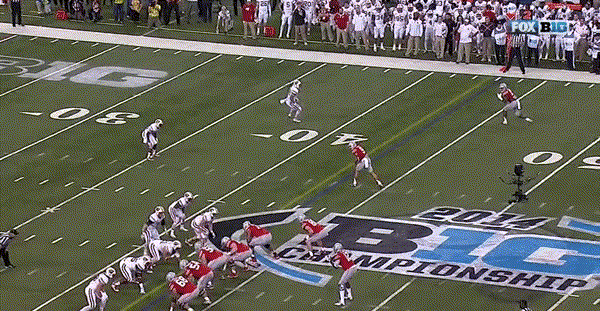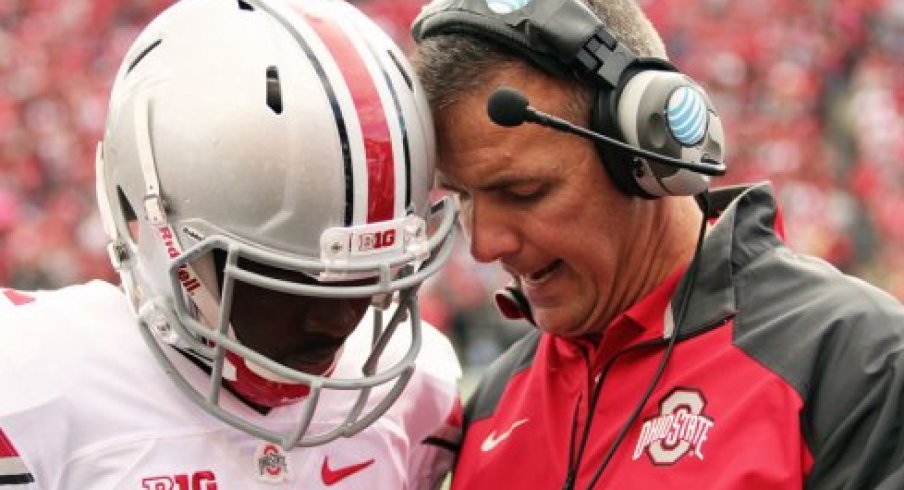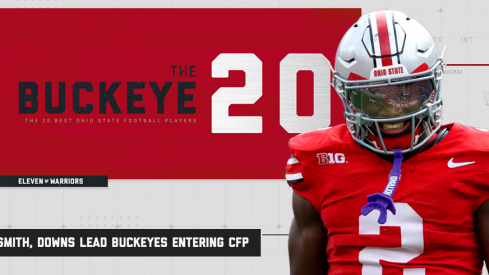After leaning on a wildly successful vertical play-action game on the way to the first College Football Playoff championship, head coach Urban Meyer and the Ohio State offense seek to correct what ailed an inconsistent downfield passing attack in 2015.
During the final three games of the 2014 season (Wisconsin, Alabama, and Oregon), the Buckeye offense ran a masterful combination of Meyer’s signature tight zone/gap-scheme run game and vertical play-action attack to the tune of 143 combined points (47.6 points per game) against college football’s toughest competition. Simply put, opposing defenses had no answer to the eventual champion’s vertical play-action pass game run off a dominant run game.
Quarterback Cardale Jones averaged over 10.7 yards per attempt, while current New York Jets wide receiver Devin Smith averaged a blistering 38.4 yards per reception on the way to four touchdowns. On the season, starters J.T. Barrett (who was lost for the season after suffering a fractured ankle in the regular season finale against Michigan) and Jones combined to average over 9 yards-per-passing-attempt, while Smith led the nation in yards-per-catch with a gaudy 28.2 average.
Returning a loaded starting lineup that included Braxton Miller at the ‘H’ position, expectations for the 2015 season were sky-high. Instead, fans witnessed a lackluster offense (by Urban Meyer’s standards) that failed to execute and struggled to find an identity for most of the season. An area of glaring weakness was an inability to consistently create explosive downfield plays through the air off play-action.
The 2015 stats stand in stark contrast to the previous season. Jones and Barrett averaged 7.6 yards per attempt compared to 9.1 yards the previous season. Leading wide receiver and potential first-round draft pick Michael Thomas led the team in yards-per-reception with a 13.9 average, a drop off of over 14 yards-per-catch. While the Ezekiel Elliott-led run game still averaged over 245 yards-per-contest, the Buckeye rushing attack experienced periods of inconsistency, seriously affecting the opportunity for play-action concepts.
It is impossible to nail down a single factor that led to this deficiency on the offensive side of the ball. A myriad of factors likely contributed to the fall off, including the lack of a true deep threat to replace Smith, poor execution of vertical play-action concepts, and an erratic offensive scheme that seemingly had too many cooks in the kitchen calling the plays.
Let’s start by breaking down the game tape to analyze how the Buckeye offense beat teams deep off play-action during the 2014 championship-run. During Ohio State’s mid-season premier Big Ten matchup with the No. 9 ranked Michigan State Spartans, the offense hit several vertical passes including a beautiful 45-yard score down the seams against Sparty’s base Cover 4.
Showing 11 personnel (1 tailback and 1 tight end) and twin receivers to the boundary (short-side of the field), the Buckeye offense is showing run via their alignment as they often run Split and Tight Zone out of this formation. The offensive line uses slide protection to the right, with the tight end arcing across the formation to cover the right C-gap. The arc block serves to false key the defense as many will use the backfield tight end’s motion to as a ‘tell’ to run or pass. The arc motion should key the defense to run, however the play and protection is designed to give this appearance (known as a false key) before pushing the ball downfield.

Notice how the play-action pulls up the linebackers while the entire offensive line slides to the right. Ezekiel Elliott stays in the block after executing the fake, creating a seven-man blocking front that gives the vertical routes the necessary time to develop.
Move your eyes to the field safety located just below the left hash. The arc-motion eliminates the threat of a vertical route from the No. 2 receiver, so he zones up by opening to protect the empty middle of the field. Focus on the helmet.

Although he has opened his hips and gained depth, his eyes are still in the backfield due to the play-action, preventing him from hitting fifth gear until just before the 30-yard line. This slight delay prevents help for the weak safety on Devin Smith’s seam route. The delay in depth is slight, but that is all it takes for a playmaker of Smith’s caliber to beat a defensive back vertically.
Our next example takes us to Ohio State’s 59-0 Big Ten Championship game trouncing of the Wisconsin Badgers.
Former offensive coordinator Tom Herman has flared the tailback out from his typical backfield alignment to create an empty look, with three receiving threats to the field (wide-side).
Generally an empty formation is a tip-off to a pass play; however Ohio State and other power-spread offense like Clemson and Auburn utilize designed quarterback runs out of this alignment, so the ground game must be accounted for in addition to the pass. As a result the defense must keep six players in the box to cover all run gaps. The SAM (strong-side linebacker) is likely responsible for the backfield tight end while the safety just below the right hash has deep responsibility, although the defense could be in a Cover 0 look. Without the play call it is impossible to say which with 100 percent certainty, but the odds say Cover 1.
The defense appears to be in a form of off-man coverage with the cornerbacks and strong-side safety playing 8-9 yards off the ball to read through the 3-step passing game, breaking on any short routes while maintaining a cushion over anything intermediate or deep.
The offense is running a three-man Smash-Fade concept in which:
- The tailback will take two steps and then stand in place to hold the outside defender
- The slot receiver will run a corner route or 7, pressing vertical down the seam before faking to the post and breaking back to the corner.
- The ‘H’ receiver will run a deep crossing route across the field, creating a three-level deep-to-intermediate-to-short concept.
The deep safety has crept up to 10 yards depth pre-snap, likely expecting the quarterback run. As a result of the creep, the safety has little chance of getting back to his deep middle to provide help over the top against anything vertical.
Watch the safety and both linebackers at the snap.

All three defenders bite hard on Jones’ play-action fake (the forward step and dip of the head). This leaves the five remaining defenders in man-coverage with no deep help.

Let’s move on to Smith’s route.

The current New York Jet’s route is a thing of beauty. The fake to the post causes the defender to dip inside, forcing him to make a tough change of direction when Smith cuts back to the corner. The separation is immediate and the ball is perfectly thrown, leading to an easy six points.
Our final example comes against the Oregon Ducks in the 2014 College Football Playoff National Championship Game.
Elliott and Jones have already established a strong ground game with an expert mix of tailback and quarterback-designed runs. The Oregon defense is on their heels and has shown no ability to adjust to Ohio State’s play calling. Tom Herman is in a groove.
The Buckeye offense starts in a 'quad' look (two receivers to each side of the field) before motioning to a bunch at the bottom of the screen. The offense is running a flood concept, looking to attack the Ducks' weak-side with a 3-level route concept.

The vital routes to Oregon’s Cover 3 look is the clear out by the ‘X’ receiver to run off the cornerback, the tailback flat (after executing the play-action fake), and the deep cross by Jalin Marshall (the outside receiver in the bunch). The goal is to vertically stretch the WILL located just above the left hash pre-snap. As this defender is responsible for the curl/flat, this route combo will create a hi-lo stretch. If the WILL gains depth to cushion the crossing route, throw the flat route in front of him. If the WILL jumps the flat, throw the crossing route behind him.
Keep your eyes on the curl/flat defender:

Notice how Elliott’s flat route of the fake holds the curl/flat defender, allowing Corey Smith's crossing route to hit behind him with a clear throwing window. The linebacker should have continued gaining depth in his drop as the defense was playing a Cover 3 variant with three deep and five underneath defenders. The WILL and MIKE do not do a bad job reading the play-action but the play design has created the hi-lo stretch Herman was looking for. Although Smith eventually fumbled the ball away on his run after the catch, the play illustrates the creativity behind Meyer’s play-action pass concepts.
After seeing what effective play-action looks like within the offense, let’s breakdown two examples from this season in which the offense misfired on the long ball.
Our first example comes from the Buckeyes' narrow 20-13 victory over Northern Illinois. The Buckeye offense was particularly stagnant in this early season match-up, gaining only 298 total yards and precipitating a quarterback change from starter Cardale Jones to J.T. Barrett. The offense is attempting to run a variation of Four Verticals using a ‘Pin’ concept (Post/Dig) from the ‘H’ receiver and tight end. The defense appears to be in a Cover 4 trips check (although this could be Cover 3’s Maple as well), pushing the coverage to the three-receiver side.

The issue that leads to the eventual interception is the tailback’s alignment to the three-receiver surface. The MIKE will take the tailback when he enters his route just beyond the line of scrimmage, leaving the WILL to drop into the weak hook zone as he has no threat in his flat.

Notice the linebacker’s depth, taking him right into the window the offense wants to hit with the dig route. Adding insult to injury the strong safety (located just above the right hash) initially makes a coverage mistake, chasing the dig route rather than carrying the post from the No. 2 receiver. Unfortunately, Barrett appears to be past this read in his progression. It is impossible to know exactly what he saw, but he clearly DID NOT see the defender in the weak hook zone.
Our final example comes from the Buckeye’s lone loss of the 2015 season, a last-second 17-14 defeat to Michigan State that knocked the squad out of playoff contention. On a windy and rainy day, aside from as single second quarter drive, the offense found little success on the ground and no success through the air. While the weather conditions certainly played a role in the inability to connect on a single long ball, the execution was lacking when play-action was dialed up.
During a tie ball game with 5:49 to go in the fourth quarter, the offensive coaching staff dialed up a play-action concept utilizing max protection from two tight ends and the tailback. Leading receiver Michael Thomas was the target, running a sluggo (slant and go) double move off a fake jet sweep.

We can see the ball was underthrown, forcing Thomas to become a defender from the television footage, but a closer look at his route shows that there was a small window of opportunity to hit.

The receiver’s double-move did a great job turning the cornerback to the inside, forcing a baseball turn that created separation. The throw left much to be desired though, being both under-thrown and forcing Thomas to drift to the sideline. This play was emblematic of the offense’s struggle to reliable complete anything vertical.
Moving onto the 2016 season, a core of young and talented receivers and another year of Barrett leading the offense will hopefully banish last season’s struggles to a distance memory. Urban Meyer and his offensive staff know what has to be fixed. Will they make the necessary personnel, concept, and play-calling changes? Only time will tell.


